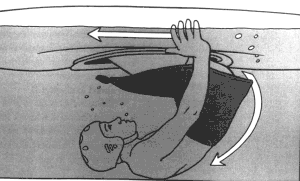
Often, however, when negotiating some obstacle, the impact of the side wave puts the canoe over the side. To avoid tipping over, we need to prop up the canoe with an oar. So we pull the oar on the water, on the tilt side, and the weight of the body is transferred to the other side. In case the kayak does not return to balance after the first support, we repeat this maneuver with this, that we carry the feather forward in the water and make a pull until it is balanced.
Finally, the method of avoiding the dangerous braid should be mentioned, as given by an experienced canoeist: „…Sailing with a person of the sex of the so-called. weak, I try to position my canoe in this way in front of the next rough current in the bend of the river, to drive into its calm and "clean” shoulder. There is a slight fall of the water into the mainstream, the largest at the beginning of the bend. Suppose, that we are approaching the right two-hundred-meter braid. At a distance of 100-150 m, we canoe down to the left bank in this way, to be 3-6 m to the left of the dangerously turbulent current at the very beginning of the bend. With short and strong thrusts with the oar (sometimes double from the right side of the canoe) we keep at a safe distance from the current, on which the river pushes us. We go on and when the current changes to the left bank, we cross the now-safe end of the current right-hand stream at an angle and again enter the calm water, this time leaving a rough current on the left. During this passage we have to row rhythmically with redoubled strength, pushing the water away more strongly on the left side of the kayak. We take care in this, so that the kayak does not turn its stern forward”.
As already stated above, mountain rivers have various obstacles that are difficult to overcome. Noticing and recognizing obstacles in time, it will allow you to overcome or bypass it without unpleasant tipping over.
A tipper - which many of us can meet not only in mountain waters, but also the lowlands, it will end only with a bath, if we stay calm, composure and we will follow the advice below. If the capsize in shallow and standing water, where we have the so-called. grunt, with efficient action it will not be difficult for us to bring our unit to such a state, to be fit for further journeys. We fish out and secure the contents of the kayak, and then pour the water out of it:
1. Crew (track) raises its beak, to pour out some of the water, and then the helmsman, lifting the stern, pours out the rest, slightly tilting the canoe left and right
2. We turn the canoe over and put it on the water
3. We bring it to the shore, we load dry parts, while the wet ones are spread on the canoe.
On running water, when we feel the ground under our feet, one catches gear, the other tries to lead the vessel to shallower water, to avoid being carried to the deep. We do the rest of the steps as above.
In deep water, We check immediately after departure, whether our companion is on the surface of the water, the weaker one is sent ashore with the task of towing the kayak, and we catch and secure the equipment ourselves.
In the event of a fall on a lake, we try: secure more valuable items, then turn the kayak over or tow it ashore. In fact, we try to reverse the kayak as quickly as possible and tow it to the less swimming companion, so that he can hold onto the bow or stern. When the unit cannot be turned over, we fish out rescue equipment (circle, I get, tract) and give it to the weaker, we take care of the equipment ourselves, keeping in mind the flowing companion.
If we turn the canoe over, we are trying to empty it partially of water, and then go inside it and pour out the rest. Entry to the kayak is from the stern, in the following way: stronger (more efficient) a crew member raises his bow up, dipping the stern, and the other, grabbing the back of the kayak as far as possible, straddling the stern into its interior, going then to the bow. Then it tries to submerge its beak and allow the other to enter, in a similar way to the stern, while gradually moving backwards, to keep the kayak balanced.